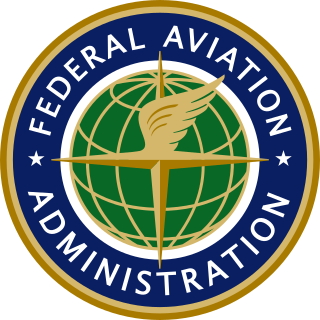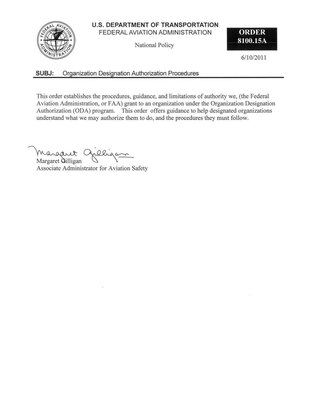
The Federal Aviation Administration (FAA) is a U.S. federal government agency within the U.S. Department of Transportation which regulates civil aviation in the United States and surrounding international waters. Its powers include air traffic control, certification of personnel and aircraft, setting standards for airports, and protection of U.S. assets during the launch or re-entry of commercial space vehicles, powers over neighboring international waters were delegated to the FAA by authority of the International Civil Aviation Organization.
The Federal Aviation Regulations (FARs) are rules prescribed by the Federal Aviation Administration (FAA) governing all aviation activities in the United States. The FARs comprise Title 14 of the Code of Federal Regulations. A wide variety of activities are regulated, such as aircraft design and maintenance, typical airline flights, pilot training activities, hot-air ballooning, lighter-than-air aircraft, human-made structure heights, obstruction lighting and marking, model rocket launches, commercial space operations, model aircraft operations, Unmanned Aircraft Systems (UAS) and kite flying. The rules are designed to promote safe aviation, protecting pilots, flight attendants, passengers and the general public from unnecessary risk.

A type certificate signifies the airworthiness of a particular category of aircraft, according to its manufacturing design. Certification confirms that the aircraft of a new type intended for serial production is in compliance with applicable airworthiness requirements established by the national air law.

In aviation, an instrument approach or instrument approach procedure (IAP) is a series of predetermined maneuvers for the orderly transfer of an aircraft operating under instrument flight rules from the beginning of the initial approach to a landing, or to a point from which a landing may be made visually. These approaches are approved in the European Union by EASA and the respective country authorities and in the United States by the FAA or the United States Department of Defense for the military. The ICAO defines an instrument approach as "a series of predetermined maneuvers by reference to flight instruments with specific protection from obstacles from the initial approach fix, or where applicable, from the beginning of a defined arrival route to a point from which a landing can be completed and thereafter, if landing is not completed, to a position at which holding or en route obstacle clearance criteria apply."
DO-178B, Software Considerations in Airborne Systems and Equipment Certification is a guideline dealing with the safety of safety-critical software used in certain airborne systems. It was jointly developed by the safety-critical working group RTCA SC-167 of the Radio Technical Commission for Aeronautics (RTCA) and WG-12 of the European Organisation for Civil Aviation Equipment (EUROCAE). RTCA published the document as RTCA/DO-178B, while EUROCAE published the document as ED-12B. Although technically a guideline, it was a de facto standard for developing avionics software systems until it was replaced in 2012 by DO-178C.

An electronic flight bag (EFB) is an electronic information management device that helps flight crews perform flight management tasks more easily and efficiently with less paper providing the reference material often found in the pilot's carry-on flight bag, including the flight-crew operating manual, navigational charts, etc. In addition, the EFB can host purpose-built software applications to automate other functions normally conducted by hand, such as take-off performance calculations. The EFB gets its name from the traditional pilot's flight bag, which is typically a heavy documents bag that pilots carry to the cockpit.
An aircraft part is an article or component approved for installation on a type-certificated aircraft. Approval for these parts is derived from the jurisdictions of the countries that an aircraft is based. In the United States, the Federal Aviation Administration oversees the approval for these parts under Federal Aviation Regulation Part 21.
Practical Test Standards or PTS are sets of guidelines, standards, and criteria formerly used in the United States by Federal Aviation Administration (FAA) Safety Inspectors or Designated Pilot Examiners to determine the suitability of airmen to be issued an airman certificate by conducting a checkride. Each certification level features unique criteria published by the FAA both electronically and in hard copy format. The system was partially superseded, beginning on June 15, 2016, by a new set of publications called Airman Certification Standards, though the PTS is still used for select FAA practical tests.
Parts Manufacturer Approval (PMA) is an approval granted by the United States Federal Aviation Administration (FAA) to a manufacturer of aircraft parts.

In aviation, airworthiness is the measure of an aircraft's suitability for safe flight. Initial airworthiness is demonstrated by a certificate of airworthiness issued by the civil aviation authority in the state in which the aircraft is registered, and continuing airworthiness is achieved by performing the required maintenance actions.
A Designated Airworthiness Representative (DAR) is a private person designated by the United States Federal Aviation Administration to act on its behalf in the certification of type certificated and amateur-built aircraft for the issuance of airworthiness certificates, special flight permits, import aircraft, export certificates for products and articles, conformity inspections, and field approvals for repair and alterations. Most DARs have limited and/or certain "functions" authorized by the FAA based on their experience and technical background. A DAR may charge a fee for their services. Qualifications and policies for appointment of Designated Airworthiness Representatives are established in FAA Order 8100.8.
Localizer performance with vertical guidance (LPV) are the highest precision GPS aviation instrument approach procedures currently available without specialized aircrew training requirements, such as required navigation performance (RNP). Landing minima are usually similar to those of a Cat I instrument landing system (ILS), that is, a decision height of 200 feet (61 m) and visibility of 800 m. Lateral guidance is equivalent to a localizer, and uses a ground-independent electronic glide path. Thus, the decision altitude, DA, can be as low as 200 feet. An LPV approach is an approach with vertical guidance, APV, to distinguish it from a precision approach, PA, or a non-precision approach, NPA. WAAS criteria includes a vertical alarm limit more than 12 m, but less than 50 m, yet an LPV does not meet the ICAO Annex 10 precision approach standard.
The Modification and Replacement Parts Association is the Washington, D.C.-based trade association that represents manufacturers of government-approved after market aircraft parts. These aircraft parts are often known as PMA parts, from the acronym for Parts Manufacturer Approval. The manufacture of PMA parts is regulated in the United States by the Federal Aviation Administration.
DO-178C, Software Considerations in Airborne Systems and Equipment Certification is the primary document by which the certification authorities such as FAA, EASA and Transport Canada approve all commercial software-based aerospace systems. The document is published by RTCA, Incorporated, in a joint effort with EUROC and replaces DO-178B. The new document is called DO-178C/ED-12C and was completed in November 2011 and approved by the RTCA in December 2011. It became available for sale and use in January 2012.

Advisory circular (AC) refers to a type of publication offered by the Federal Aviation Administration (FAA) to "provide a single, uniform, agency-wide system … to deliver advisory (non-regulatory) material to the aviation community." Advisory circulars are now harmonized with soft law Acceptable Means of Compliance (AMC) publications of EASA, which are nearly identical in content. The FAA's Advisory Circular System is defined in FAA Order 1320.46D.

FAA Order 8130.34D, Airworthiness Certification of Unmanned Aircraft Systems, establishes procedures for issuing either special airworthiness certificates in the experimental category or special flight permits to unmanned aircraft systems (UAS), optionally piloted aircraft (OPA), and aircraft intended to be flown as either a UAS or an OPA.
The Aviation Safety Knowledge Management Environment (ASKME) is a software suite for certifying new aircraft and modified aircraft. It was created for the Federal Aviation Administration (FAA) Aircraft Certification Service (AIR).

The Boeing 737 MAX passenger airliner was grounded worldwide between March 2019 and December 2020 – longer in many jurisdictions – after 346 people died in two similar crashes: Lion Air Flight 610 on October 29, 2018, and Ethiopian Airlines Flight 302 on March 10, 2019. The Federal Aviation Administration initially affirmed the MAX's continued airworthiness, claiming to have insufficient evidence of accident similarities. By March 13, the FAA followed behind 51 concerned regulators in deciding to ground the aircraft. All 387 aircraft delivered to airlines were grounded by March 18.

The Organization Designation Authorization (ODA) program was established by FAA Order 8100.15 . The ODA, in conjunction with the Federal Aviation Administration (FAA), grants airworthiness designee authority to organizations or companies. The regulations addressing the ODA program are found in Title 14 of the Code of Federal Regulations part 183, subpart D, sections 183.41 through 813.67.

FAA Order 8110.37 , Designated Engineering Representative (DER) Handbook, is a handbook of procedures, technical guidelines, limitations of authority, tools, and resources for Designated Engineering Representatives (DERs), who are appointees of the Federal Aviation Administration. Both DERs and the FAA offices managing them have individual and mutual roles and responsibilities in the certifications of safety of aircraft and aviation systems. This handbook provides a better understanding of these roles. Although intended for the roles of DERs, this order may be useful to ODA engineering Unit Members, who are effectively DERs managed by aviation manufacturers rather than by the FAA.







